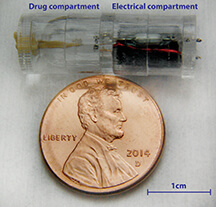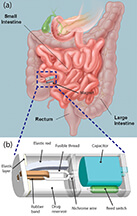'Smart capsule' is potential new drug-delivery vehicle
July 14, 2015
 |
|
A new "smart capsule" under development could deliver medications directly to the large intestines to target certain medical conditions. The prototype is about as large as a 000-size gelatin capsule. (Purdue University photo/Babak Ziaie) |
WEST LAFAYETTE, Ind. — A new "smart capsule" under development could deliver medications directly to the large intestines to target certain medical conditions.
"Usually, when you take medication it is absorbed in the stomach and small intestine before making it to the large intestine," said Babak Ziaie, a professor of electrical and computer engineering at Purdue University. "However, there are many medications that you would like to deliver specifically to the large intestine, and a smart capsule is an ideal targeted-delivery vehicle for this."
Such an innovation might be used to treat of irritable bowel syndrome, Crohn's disease and a potentially life-threatening bacterial infection called Clostridium difficile in which the body loses natural microorganisms needed to fight infection.
Findings are detailed in a research paper that appeared online and will be published in a future print issue of the Institute of Electrical and Electronics Engineers (IEEE) Transactions on Biomedical Engineering. The paper was authored by graduate students Wuyang Yu, Rahim Rahimi and Manuel Ochoa; Rodolfo Pinal, an associate professor of industrial and physical pharmacy; and Ziaie.
People are sometimes treated for C. difficile by transplanting feces from another person into the patient's large intestine, which provides vital microbes. However, it might be possible to convert the microbes into a powder through freeze-drying and deliver them with smart capsules instead, Ziaie said.
 |
|
The smart pill is designed to release powdered medication just before reaching the ileocecal valve, where the small and large intestine meet. (Purdue University photo/Babak Ziaie) |
Researchers tested the smart capsule with a "fluidic model" that mimics the gastrointestinal tract and also using an experiment that recreates the changing acidity and peristalsis of the stomach and intestines as food passes through the digestive system.
"It takes up to 12 hours to get to the large intestine, so we wanted to make sure the smart capsule can withstand conditions in the gastrointestinal tract," Ziaie said.
The capsule is powered by a capacitor that is charged before use. A switch inside the capsule is activated by a magnet that could be worn on the patient's waist. As the capsule meanders through the intestines it eventually comes close to the magnet, activating the switch and releasing a spring-loaded mechanism that opens the capsule, which delivers the medication.
The prototype capsule is about the same size as a 000-size gelatin capsule and is designed to release the powdered medication just before reaching the ileocecal valve, where the small and large intestines meet.
The researchers have filed a provisional U.S. patent application through Purdue’s Office of Technology Commercialization of the Purdue Research Foundation.
The research is ongoing and is based at Purdue's Birck Nanotechnology Center. Future work may involve human patients.
Writer: Emil Venere, 765-494-4709, venere@purdue.edu
Source: Babak Ziaie, 765-494-0725, bziaie@purdue.edu
Note to Journalists: An electronic copy of the research paper is available by contacting Emil Venere, 765-494-4709, venere@purdue.edu. A video of the smart capsule passing through the intestines is available at https://youtu.be/sU-2l3NS1SI
ABSTRACT
A Smart Capsule with GI-Tract-Location-Specific Payload Release
Wuyang Yu, Rahim Rahimi, Manuel Ochoa, IEEE Graduate Student Member, Rodolfo Pinal, and Babak Ziaie, IEEE Senior Member
Albert Kim, Junyoung Kim, Shirley Rietdyk, and Babak Ziaie
In this paper, we present a smart capsule for location-specific drug release in the gastrointestinal (GI) tract. Once activated through a magnetic proximity fuse, the capsule opens up and releases its powdered payload in a location specified by an implanted miniature magnetic marker or an externally-worn larger magnet. The capsule (9 mm × 26 mm) comprises of two compartments; one contains a charged capacitor and a reed switch while the second one houses the drug reservoir capped by a taut nylon thread intertwined with a nichrome wire. The nichrome wire is connected to the capacitor through the reed switch. The capacitor is charged to 2.7V before ingestion and once within the proximity of the permanent magnet; the reed switch closes, discharging the capacitor through the nichrome wire, melting the nylon thread, detaching the cap and emptying the drug reservoir.

